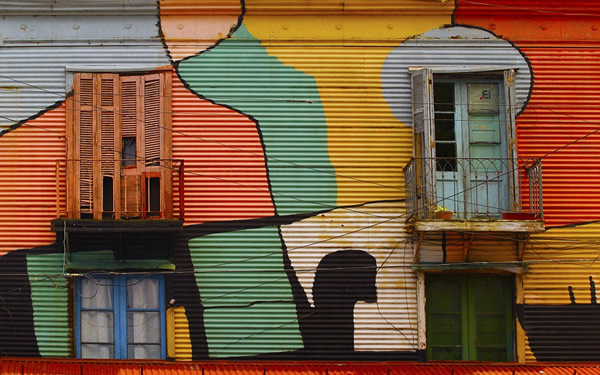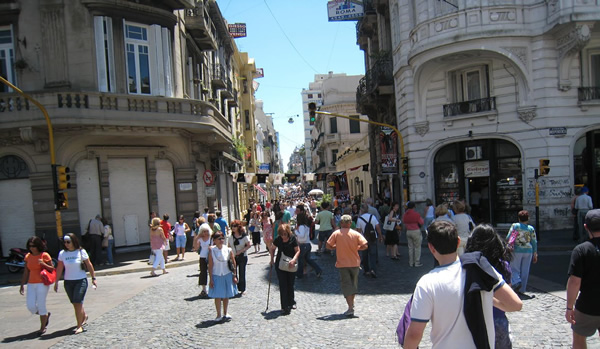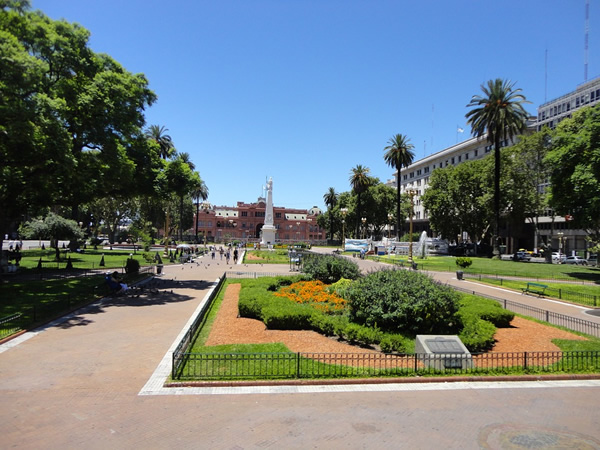Living in Buenos Aires
Enjoy a Better Life in the Capital of Argentina
By Shanie Matthews
Resources updated 10/10/2023 by Transitions Abroad

|
|
One of many colorful and lively districts in Buenos Aires.
|
Which city is “Paris of the Southern Hemisphere,” the birthplace of sultry, sensual Tango and Latin America’s Polo capital? The center of non-stop action, beautiful people, and European architecture is none other than Buenos Aires. A city that seduces in so many ways, Buenos Aires remains a hotspot for those looking to live abroad.
The trend for those looking to move outside their motherland is growing. People are looking to expand their horizons given the ease of travel, communication via the Internet, and the global economy. Even though the world is becoming smaller, there are still many choices when choosing where to live overseas. Buenos Aires has slowly made its way up the ranks as one of the best options. The city offers many enjoyable activities, exciting nightlife, a high standard of living, and excellent housing options in various neighborhoods. Most importantly, the city offers a rich and varied culture and is home to a population open to foreigners. Finally, despite all its financial ups and downs, Buenos Aires is still an excellent value for those coming with Dollars, Euros, and Pounds.
Argentina's largest metropolis, at over 13 million Porteños (the nickname given to inhabitants of Buenos Aires), is magnetic and known to capture visitors' hearts. The greater population of Buenos Aires is a mixture of Italian, German, and Spaniard descent — which makes it an authentic European culture within Latin America. Deby Novitz, a tango dancer from the United States, initially traveled to Buenos Aires to enjoy its tango dance halls. But after a series of trips, she knew that she had found her new home, "I first came to Buenos Aires in 2000 to dance tango. I came back in the spring of 2001, again to dance. I decided to go in December 2001 for the holidays, once again to dance. It was probably one of the worst times in history for the country. I was really moved by the spirit of the people. That began my love affair with Buenos Aires. Although my first reason for coming to Buenos Aires was to dance tango, I moved here because I love Buenos Aires and the people. I can easily live here without tango."
Choosing from the Neighborhoods of Buenos Aires
The heart of Buenos Aires consists of capital federal, the accumulation of 48 varying barrios. There are a few neighborhoods within the bustling corazon of the city that are recommended places to call home for those looking to be in the center of the action.

|
|
The lively street life in San Telmo, Buenos Aires, amid European-influenced architecture. Photo by Shanie Matthews.
|
The Recoleta neighborhood is probably the most famous of Buenos Aires neighborhoods. Its fame began with the invasion of the Yellow Fever. In the late 1800s, the disease cast a stormy cloud over much of Buenos Aires. The rich, running from death and sickness, took shelter in the small Recoleta barrio. Shortly after that, a marble mausoleum cemetery was erected by the same name. This became the place for the who's who to be laid to rest, and it is said that it is more expensive to be buried in Recoleta than to live an entire lifetime in Buenos Aires. Today, the spooky and fascinating cemetery encompasses 13.5 acres. It is surrounded by a grass park that hosts a large craft fair on the weekends.
Some of the city's top restaurants and active nightclubs in Recoleta are bordering the grass park. It is also home to the Metropolitan Design Center. This area is considered the most expensive to live in, though Puerto Madero has begun to take the lead as of late. Despite a higher echelon reputation, Recoleta offers monthly rentals starting around $460 for a small one-bedroom/one-bath (2023).
Puerto Madero was once a decrepit port area. Yet, it has recently been rejuvenated into the wealthy sector of the city center. The zone is decorated with shiny high-rise buildings, manicured river walkways, and streets, all paying homage to influential women in history. Impressive government buildings are also sprinkled throughout the neighborhood, making it a popular place to live for expats working in governmental positions. The boardwalk framing the river is home to an array of excellent dining options and one of Buenos Aires' universities. Beyond the waterway is a grouping of fancy apartment buildings, an eclectic mix of boutique shops, and a large outdoor summer concert series arena. Due to the recent remodeling, living is more expensive here. An average price for a one bedroom/one bath will start near the US$ 1,000 range. The recent boom has also affected real estate prices, making what was once one of the cheapest markets now one of Buenos Aires' top-end real estate investments.
For those looking to purchase something that is on its way up, check out the San Telmo neighborhood. The true birthplace of Tango, this neighborhood is still dressed in cobblestone streets and buildings dripping with history. The area has recently taken a path towards refurbishment. Many abandoned and timeworn buildings are being overhauled into high-end hotels and restaurants. There is also a large music and bar scene providing nightly entertainment. A huge craft, antique, and art fair brings out tourists, locals, and street vendors every Sunday. San Telmo still offers the safest and cheapest option for people looking for an immersion in the authentic cultural life of Buenos Aires.
Another option that is great for families is the Palermo neighborhood, which offers a zoo, a large man-made lake with rentable boats, and the impressive Japanese Gardens. This is also the largest barrio in the capital of Buenos Aires, which enables it to offer a giant market of properties for rental or purchase. The prices tend to be less than Recoleta but more than San Telmo. Palermo has also recently undergone a facelift, leaving it with a classier feel than in years gone by.
For those that love the city life but are not sure you want to live in the midst of it all, Buenos Aires offers something other than just the suburban life. You can also have the pleasure of living on a full-fledged farm within a quick drive of the metropolitan sprawl. That is what British expat Laurence De Mello does. She lives 40 minutes outside of city center. She has found the area to be the best of two worlds, “I don’t live in town, although I do stay occasionally in the city for a party or family commitment and when I do, although I enjoy the buzz, I always feel absolutely exhausted when I get back to the farm. I find Buenos Aires fascinating yet draining.” The country life not only offers a tranquil setting, but a way to make money as well. Agriculture and livestock are a main sources of income for well-established Argentines and foreigners alike.
Making a Living
Other than taking on the risks of running a farm on the outskirts of Buenos Aires, there are other options for creating a livelihood. But you do have to be creative. Novitz does a range of different jobs, “I teach English, I do translations, I give tours, I rent rooms in my apartment to tango dancers.” Being skilled in massage, chiropractic, and other forward-thinking skills can also create opportunities.
To really live well in Buenos Aires, the majority of expats agree; foreign currency is key. Enda, an Irish globetrotter that met and fell in love with his soul mate his first day in Buenos Aires agrees, “If you can continue to earn Dollars, Pounds or Euros while living here you can have a great life.” De Mello seconds that by saying, “The one piece of advice I can give to those thinking of moving to Buenos Aires is don’t come expecting to make a killing in business. Come to Buenos Aires, but make sure that you are well prepared financially. If you are not financially independent or have a good income option waiting here for you, what’s the point of coming?” De Mello makes the point that to really enjoy what the city has to offer it is important to have the ability to make an income from abroad. The common city wage will not sustain the high life of Buenos Aires, although living on the Argentine wage has not hindered Novitz’s lifestyle, “I have a good life here. I have lots of friends and people who care about me. I may not have all the things I had in the U.S, but I feel I have things that are more important.”
Enjoying Life in Buenos Aires

|
|
A park in Buenos Aires. A good place to hang out and talk with friends, in Spanish.
|
The city center and surrounding areas of Buenos Aires are filled with excitement. From the Tigre region with its casino, amusement park, and river boat trips, to the famous Boca neighborhood decorated with stucco walls washed with a rainbow of colors, tango dancers flawlessly spinning on cobblestone streets and roaming bands of musicians competing for your attention, Buenos Aires is never lacking in the entertainment department.
Of course, Tango is one of the most authentic cultural modes of enjoyment. There are tons of different areas that cater to the dance. Dinner and show cabarets are strewn through town; each has a vibe. If you are ready to move beyond being a wallflower, countless clubs offer lessons or a place to learn from the locals. There is a club every night of the week, somewhere in the city, that is packed with women and men interlaced in a sultry embrace. The clubs usually start filling up around 1 a.m. and can go on all night.
Buenos Aires offers every other version of melodic entertainment if you prefer something different than Tango but enjoy music. From blues to techno, the city is always pumping with some beat. As with the Tango dance halls, the nightclubs start at 3 or 4 a.m.
Buenos Aires also has a plethora of different ferias, museums, and art galleries. There is a cultural center in the Teatro Colón that offers world-class plays and operas and many other cultural events throughout the year.
The Final Word
Foreigners who have taken the plunge agree on one thing: Studying the Argentine Spanish, Castillano is crucial. "You need to speak the language." Says Novitz. "You would lose out on so much local culture and all the color of what it is really like to live here without it."
Buenos Aires is a city that offers a high quality of life at a discounted price compared to the United States, Europe, or England. It is home to non-stop action, first-world infrastructure, and high living standards. The gourmet restaurants, cultural events, and hundreds of acres of parks create an atmosphere that is hard to find elsewhere. Enda's life has taken a turn for the better: "My life in Buenos Aires is better than I had expected. I'm originally from Europe and this city has a European feel to it, which made the transition easier. The public transportation and safety was much better than I had anticipated as well."
But one thing stands out when choosing your home away from home: What is the overall quality of life? The answer is resoundingly positive for expats choosing Buenos Aires as their home base. De Mello feels that "…although my lifestyle is smarter and my social life better elsewhere, my family and I probably live a much healthier lifestyle here in Argentina." Enda agrees, "My quality of life is very good in Buenos Aires. There is a good sense of work/life balance here and people place a huge importance on spending time with family and friends, much more than I've observed in Europe or the U.S.A."
Shanie Matthews is a citizen of the world devoted to inspiring global sustainability, community passed-on prosperity, and environmental awareness. In addition to being a freelance writer, she is also an aspiring photographer and passionate snow skier.
|
